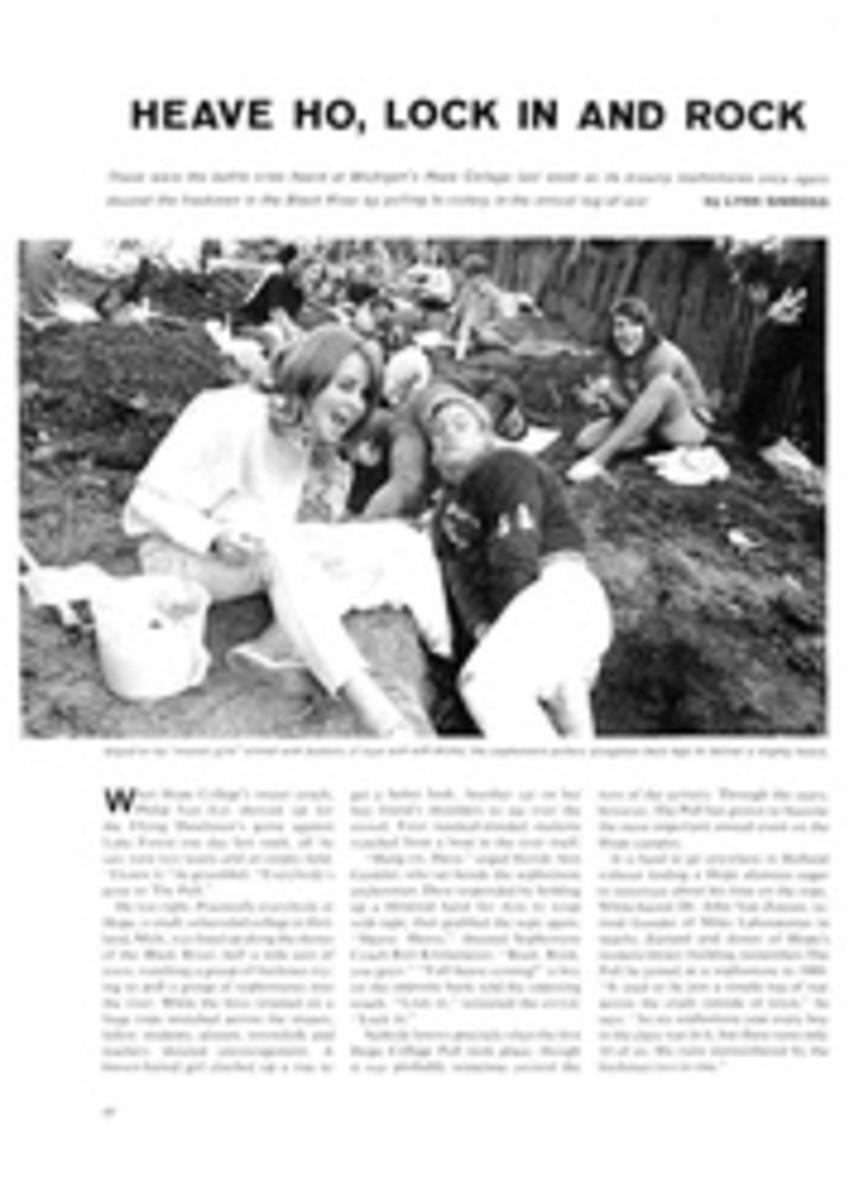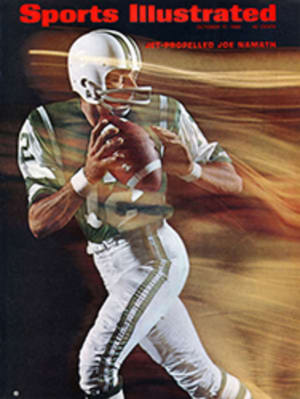
HEAVE HO, LOCK IN AND ROCK
When Hope College's soccer coach, Philip Van Eyl, showed up for the Flying Dutchmen's game against Lake Forest one day last week, all he saw were two teams and an empty field. "I knew it," he grumbled. "Everybody's gone to The Pull."
He was right. Practically everybody at Hope, a small, sobersided college in Holland, Mich., was lined up along the shores of the Black River, half a mile east of town, watching a group of freshmen trying to pull a group of sophomores into the river. While the boys strained on a huge rope stretched across the stream, fellow students, alumni, townsfolk and teachers shouted encouragement. A brown-haired girl climbed up a tree to get a better look. Another sat on her boy friend's shoulders to see over the crowd. Four nautical-minded students watched from a boat in the river itself.
"Hang on, Dave," urged blonde Ann Gunkler, who sat beside the sophomore anchorman. Dave responded by holding up a blistered hand for Ann to wrap with tape, then grabbed the rope again. "Heave. Heave," shouted Sophomore Coach Ron Kronemeyer. "Rock. Rock, you guys." "Full heave coining!" a boy on the opposite bank told the opposing coach. "Lock in," screamed the crowd. "Lock in."
Nobody knows precisely when the first Hope College Pull took place, though it was probably sometime around the turn of the century. Through the years, however, The Pull has grown to become the most important annual event on the Hope campus.
It is hard to go anywhere in Holland without finding a Hope alumnus eager to reminisce about his time on the rope. White-haired Dr. John Van Zoeren, retired founder of Miles Laboratories in nearby Zeeland and donor of Hope's modern library building, remembers The Pull he joined as a sophomore in 1909. "It used to be just a simple tug of war across the creek outside of town," he says. "In my sophomore year every boy in the class was in it, but there were only 18 of us. We were outnumbered by the freshmen two to one."
A member of the 1935 Pull, who prefers to remain anonymous, swears that the sophomores won that year because their anchorman, Ekdal Buys, now the dignified chairman of Hope's board of trustees, tied the rope to the axle of a nearby truck when nobody was looking. John Tysse, a 1960 Hope graduate now in the admissions office, is quite frank about the chicanery that was practiced in the 1927 Pull when his father, the late Rev. John W. Tysse, was a member of the sophomore team and his uncle, Clarence Howard, pulled on the freshman side. "Dad wrapped the rope around a tree so nobody could win," admits John. "But he didn't tell my uncle about it till years later."
Such flagrant skulduggery is rare at The Pull these days. As befits an aging institution, it has become encrusted with rules, protocol and tradition, all of which make it difficult to exercise gamesmanship. But just in case anyone should try, each side employs an official judge as well as a corps of spies to peer through the bushes and keep an eye on the opposition. Spies caught in the act have been tossed in the river. One captured last week was rendered powerless by being sat on till The Pull was over.
The most important tradition concerning The Pull is that the sophomores should win it—because they are bigger, stronger, older and, like sophomores all over, superior to the callow freshmen in every way. For this reason the sophomores at Hope annually tremble at the thought that they might be the ones to disgrace age and dignity by losing to the frosh. And every freshman class clings to hopes that it might prove to be the David chosen to upset the Philistines.
Spurred by their respective dreams and nightmares, both sides start their official practice nearly three weeks before The Pull is scheduled. Hope's chaplain, the Rev. William Hillegonds, affectionately called "Wild Bill" by the students, says The Pull has become much more systematized than it was in his day—1946. "We went into the water a lot faster," he explains, "but now they have more strategy and technique."
Not only do the pullers of today have more strategy, they have girls to egg them on, and not just any girls, either. During the early practice sessions each potential puller selects a co-ed of his acquaintance to serve him as "morale girl." It is her job to cheer and comfort him, to urge him on and tape up his wounds, to sit beside him in practice and during The Pull itself, feeding him oranges, water, chocolate and encouragement.
The pullers work on alternate sides of the rope in pits dug along its length, tugging, straining, holding and heaving as their coaches order them. "Heave, men, heave," roared Sophomore Coach Kronemeyer at a practice session last week, and his men stiffened their legs for a mighty pull. "Lock in," he then shouted, and the straining pullers lay down on the rope, holding fast with hands and feet. A few minutes later Ron was calling, "Rock, rock!" and the pullers started inching up the rope with short, tugging movements.
That was the last day of practice. Next day the two teams (18 men apiece) were announced, and the two head coaches (Kronemeyer for the sophs, Chris Plasman for the frosh) were named. The pits were marked off and the 310-foot rope made ready. By Thursday afternoon there wasn't a blanket left in the local Salvation Army store as the morale girls bought them up to cover their charges. The Superior Sport Store on River Avenue sold 304 rolls of tape.
The night before The Pull, almost the entire freshman class (546) turned out to gather round a bonfire, burn an effigy of the class of 1969, drink cider, eat doughnuts and do a snake dance through the town. The sophomore pullers grumbled because their rally the night before had been a dud. "No class spirit," said blonde Morale Girl Ann dinkier. "This class has never had any spirit." But by the morning of The Pull even the lackluster sophomore rooters had caught fire.
Parents and friends drove in from the nearby countryside, and alums appeared, some carrying signs to identify them as old pullers. Faculty members headed out of their offices, and most of the student body—1,672 boys and girls—either hitched a ride or walked to the banks of the Black River. They clustered on both sides of the river, leaning on the snow fences that keep the pullers and morale girls apart from the crowd.
At 4 o'clock a whistle sounded to signal that each team had 15 minutes to dig into the pits. The Pull chairmen laid the rope across the stream and dropped the slack into the middle. The pits were readied with boards and sandbags to keep them from caving in under the pressure of straining legs. Pullers hopped in (the rules prohibit them from getting out until The Pull is over), and morale girls finished cutting long strips of tape.
At last the starting gun sounded, and The Pull began. The opposing coaches stood near the bank, hidden from each other by a wall of blankets so that opponents could not see the plays they called. But spies hidden in trees wigwagged signals across the river. One would place a hand on his head to mean, "Full heave coming," and across the river his team would brace and hold. In answer, the other team would leap to its feet, heave, lie down on the rope and lock in once again.
In just 55 minutes it was over. All 18 freshmen were "popped," i.e., pulled out of their pits, and the sophs had won. Covered with mud and gloom, one completely exhausted freshman sobbed openly as his morale girl tried her best to comfort him. "We'll get 'em next year," she said. It wasn't much comfort. The sophs always win.
PHOTO
Urged on by "morale girls" armed with buckets of tape and soft drinks, the sophomore pullers straighten their legs to deliver a mighty heave.
PHOTO
Freshman Coach Chris Plasman, a junior, calls a signal for his team with powerful sincerity.

